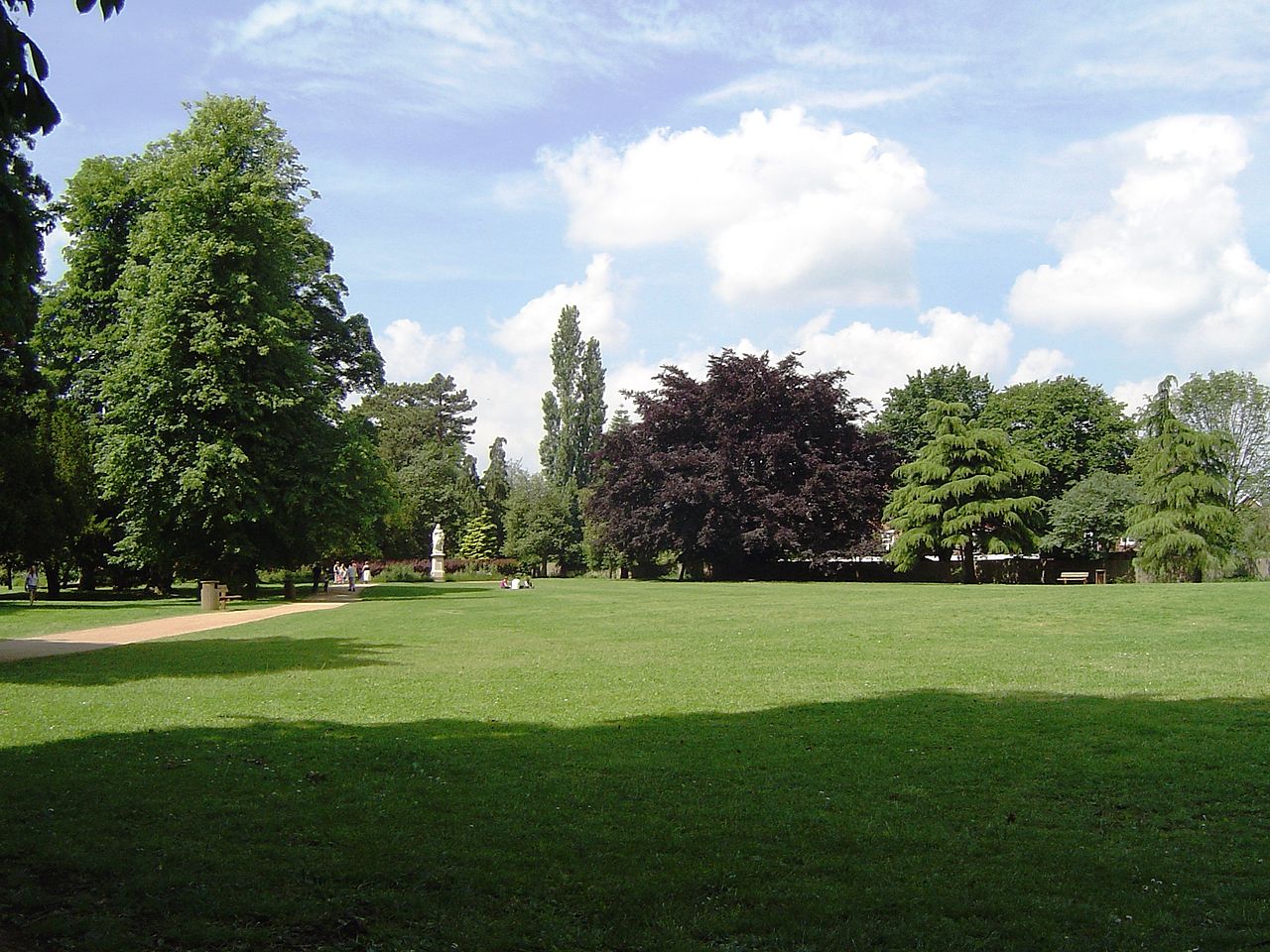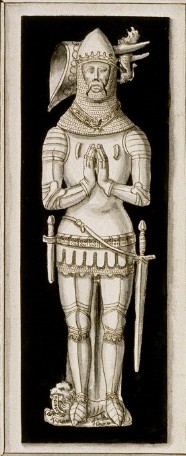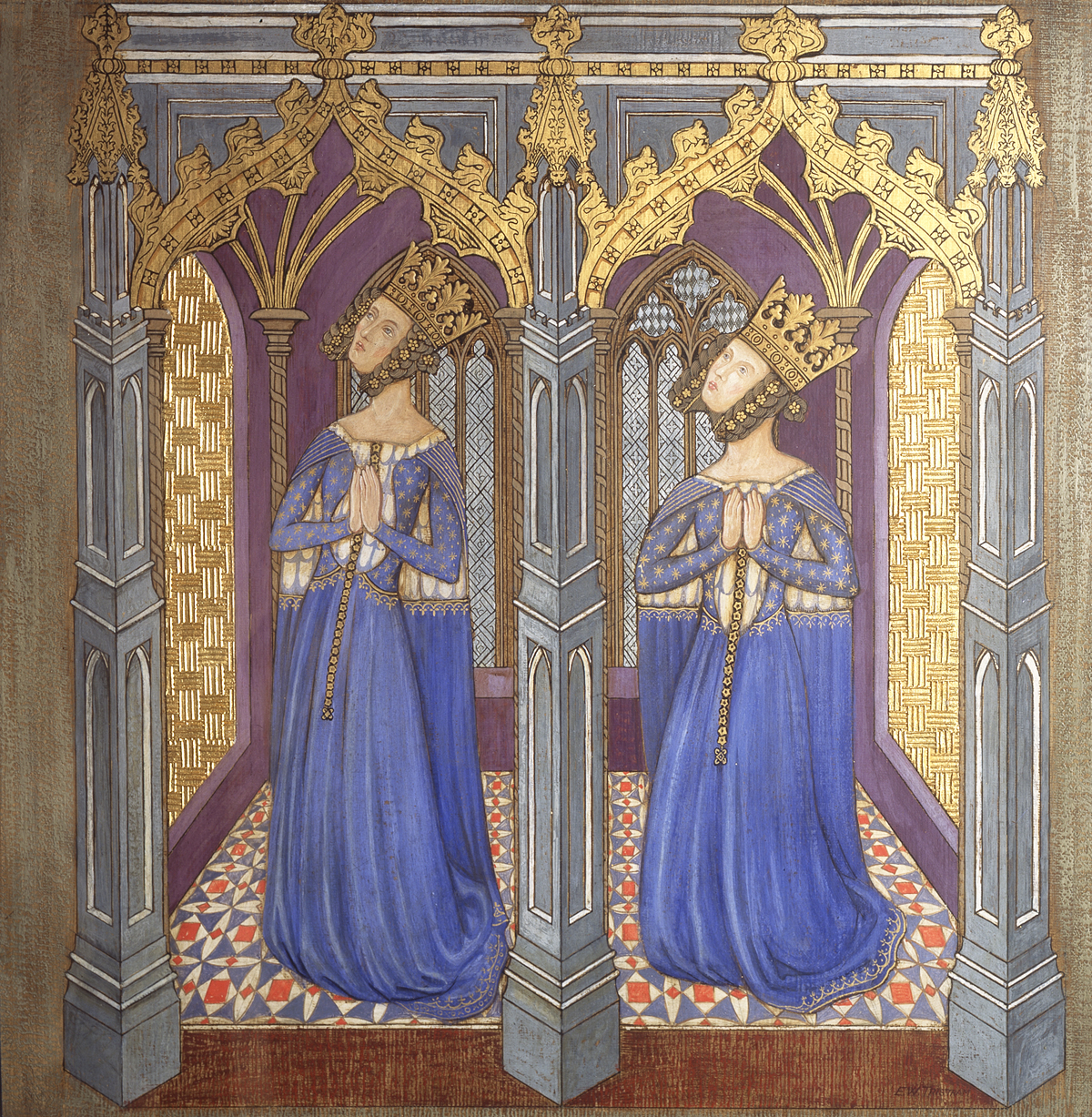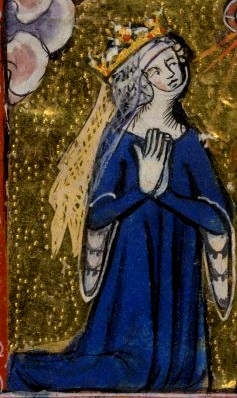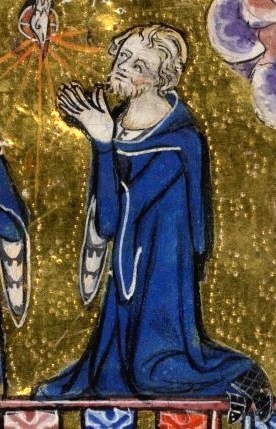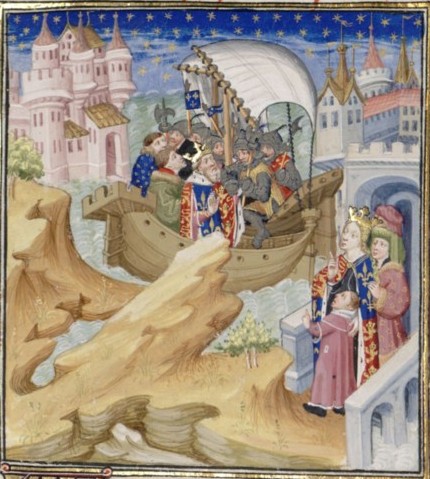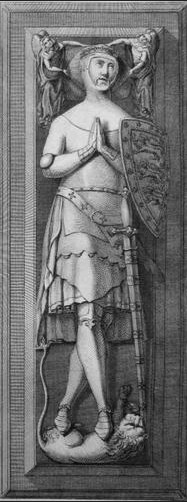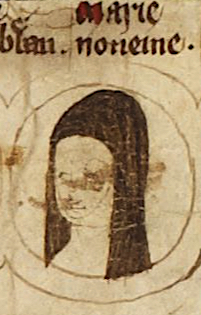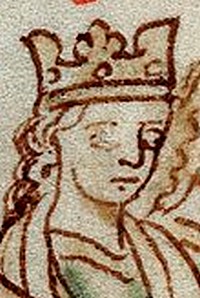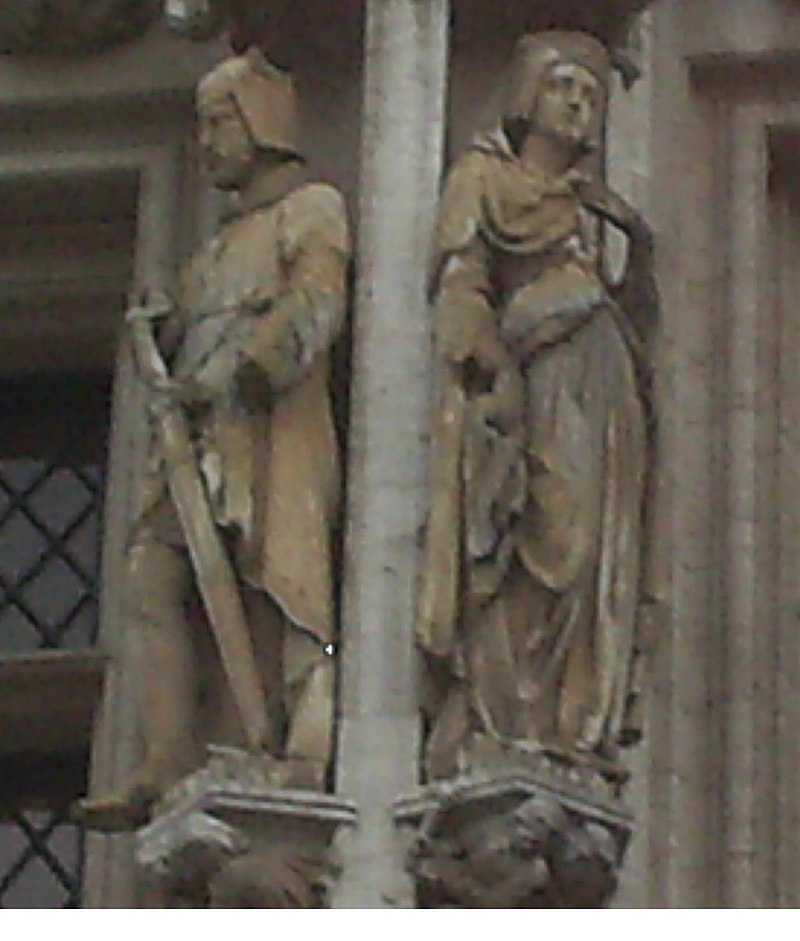by Susan Flantzer
© Unofficial Royalty 2023

Drawing of Thomas of Lancaster’s effigy, depicted in Sepulchral Monuments in Great Britain (1796); Credit – Wikipedia
Thomas of Lancaster, 1st Duke of Clarence was born on September 29, 1387, either in London, England, or at Kenilworth Castle in Kenilworth, Warwickshire, England. He was the second of the six children and the second of the four sons of King Henry IV of England and his first wife, the wealthy heiress Mary de Bohun. Thomas’ paternal grandparents were John of Gaunt (the third surviving son of King Edward III of England) and Blanche of Lancaster, the heiress of England’s wealthiest and most powerful peer, Henry of Grosmont, 1st Duke of Lancaster. It was through Blanche that the Duchy of Lancaster came into the royal family. Since the reign of King Henry IV, the Duchy of Lancaster has provided a source of independent income to the British sovereign. Thomas’ maternal grandparents were Humphrey de Bohun, 7th Earl of Hereford, and Joan Fitzalan, daughter of Richard FitzAlan, 10th Earl of Arundel. When Thomas was seven years old, his mother died while giving birth to her last child Philippa.
Thomas had five siblings:
- King Henry V of England (1386 – 1422), married Catherine of Valois, had one son King Henry VI of England
- John of Lancaster, 1st Duke of Bedford (1389 – 1435), married (1) Anne of Burgundy, no children (2) Jacquetta of Luxembourg, no children
- Humphrey, Duke of Gloucester (1390 – 1447), married (1) Jacqueline, Countess of Hainaut and Holland, no children (2) Eleanor Cobham, no children
- Blanche of England, Countess Palatine (1392 – 1409) married Ludwig III, Elector Palatine, had one son
- Philippa of England (1394 – 1430) married Eric of Pomerania, King of Denmark, Norway and Sweden, no children

Thomas’ father Henry of Bolingbroke, flanked by the lords spiritual and temporal, claims the throne in 1399. From a contemporary manuscript, British Library, Harleian Collection; Credit – Wikipedia
In 1398, Thomas’ father, then known as Henry of Bolingbroke because he was born at Bolingbroke Castle in Lincolnshire, England, quarreled with Thomas de Mowbray, 1st Duke of Norfolk, who accused him of treason. The two men planned to duel, but instead, Henry’s first cousin King Richard II banished them from England. Henry’s father John of Gaunt died on February 3, 1399, and King Richard II confiscated the estates of his uncle John of Gaunt and stipulated that his cousin Henry would have to ask him to restore the estates. Henry returned to England while King Richard II was on a military campaign in Ireland and began a military campaign of his own, confiscating the land of those who had opposed him. King Richard II eventually was abandoned by his supporters and was forced by Parliament on September 29, 1399, to abdicate the crown to his cousin Henry. King Henry IV was crowned in Westminster Abbey on October 13, 1399. Richard was imprisoned at Pontefract Castle in Yorkshire, England where he died on or around February 14, 1400. The exact cause of his death, thought to have been starvation, is unknown.
During the reign of his father King Henry IV, Thomas was second in the line of succession after his elder brother, the future King Henry V. During his brother’s reign, Thomas was the heir presumptive to the throne until his death in 1421. King Henry IV appointed his 12-year-old son Thomas Lord High Steward of England in 1399, the highest office in medieval England. Thomas held this position until his death. He also held several other positions: Chief Governor of Ireland (1401 – 1413), Lord High Admiral (1405 – 1406), Lieutenant of Aquitaine (1412 – 1413), Lord High Steward of Chester (1415), Constable of the Army (1417), and Lieutenant-General of the Army in France and Normandy (1417 and 1421). In 1399, Thomas was created a Knight of the Order of the Bath and in 1400, he was created a Knight of Order of the Garter.
In 1403, Thomas’ father King Henry IV married again to Joan of Navarre, the widow of Jean IV, Duke of Brittany, and the daughter of Charles II, King of Navarre and Jeanne of Valois. Henry IV and Joan had no children but Joan got along well with her stepchildren.

Thomas’ wife Margaret Holland; Credit – www.findagrave.com https://www.findagrave.com/memorial/46305472/margaret-de_beaufort
Sometime after November 10, 1411, when the papal dispensation was issued, Thomas married Margaret Holland (1385 – 1439). Margaret was the daughter of Thomas Holland, 2nd Earl of Kent and Alice FitzAlan. Margaret’s first marriage was to Thomas’ paternal uncle John Beaufort, 1st Earl of Somerset, son of John of Gaunt and his mistress and later his third wife, Katherine Swynford.
Thomas and Margaret had no children but Thomas was the stepfather to Margaret’s six children from her first marriage:
- Henry Beaufort, 2nd Earl of Somerset (circa 1401 – 1418), unmarried, died at the Siege of Rouen during the Hundred Years’ War
- John Beaufort, 1st Duke of Somerset (circa 1403 – 1444), married Margaret Beauchamp of Bletso, had one child Lady Margaret Beaufort who was the mother of King Henry VII of England, the first Tudor monarch
- Joan Beaufort, Queen of Scots (circa 1404 – 1445), married (1) James I of King of Scots, had six daughters and two sons including James II, King of Scots (2) Sir James Stewart, the Black Knight of Lorne, had three sons
- Thomas Beaufort, Count of Perche (circa 1405–1431), unmarried, died at the Siege of Louviers during the Hundred Years’ War
- Edmund Beaufort, 2nd Duke of Somerset (circa 1406 – 1455), married Lady Eleanor Beauchamp, had ten children, died at the First Battle of St Albans, the first battle of the Wars of the Roses
- Lady Margaret Beaufort (circa 1409 – 1449), married Thomas de Courtenay, 13th Earl of Devon, had three sons and five daughters, two sons were beheaded during the Wars of the Roses and one son was killed in battle

Battle of Baugé; Credit – Wikipedia
Thomas accompanied his brother King Henry V on his campaigns in France during the Hundred Years’ War. He commanded the English army at the Siege of Rouen in 1418 which ended in Rouen’s capture by the English. On March 22, 1421, Thomas, aged 33, was killed at the Battle of Baugé in Anjou, France. Underestimating the size of the Franco-Scottish army, Thomas decided to launch a surprise cavalry-led attack rather than use his archers. With only about 1,500 troops available, Thomas charged the French and Scots lines. The shock temporarily disordered the French and Scots, but soon Clarence and his knights were overwhelmed by the French-Scots army of 5,000. Thomas was unhorsed by a Scottish knight, Sir John Carmichael, and finished off on the ground by Sir Alexander Buchanan, probably with a mace.
Thomas’ only child, his illegitimate son, Sir John Clarence (? – 1431), known as Bastard of Clarence, had fought alongside his father in France and he accompanied his father’s remains back to England. Thomas of Lancaster, 1st Duke of Clarence was buried at Canterbury Cathedral in Canterbury, England, where his father King Henry IV was buried. Sir John Clarence participated in the procession at his father’s funeral, received land in Ireland from his uncle King Henry V, and was subsequently buried near his father at Canterbury Cathedral.

Tomb of Thomas of Lancaster, Duke of Clarence, his wife Margaret Holland, and her first husband and Thomas’ uncle John Beaufort, 1st Earl of Somerset; Credit – www.findagrave.com
Widowed for a second time, Thomas’ wife Margaret decided to live a celibate, simple life and retired to Bermondsey Abbey in London, England. She died there on December 30, 1439, aged 54. Margaret and both her husbands are buried together in a carved alabaster tomb in Canterbury Cathedral. Their effigies show Margaret lying between her two husbands.
This article is the intellectual property of Unofficial Royalty and is NOT TO BE COPIED, EDITED, OR POSTED IN ANY FORM ON ANOTHER WEBSITE under any circumstances. It is permissible to use a link that directs to Unofficial Royalty.
Works Cited
- Flantzer, Susan. (2013) King Henry IV of England, Unofficial Royalty. Available at: https://www.unofficialroyalty.com/march-20-daily-featured-royal-date/ (Accessed: December 21, 2022).
- Jones, Dan. (2014) The Plantagenets: The Warrior Kings and Queens Who Made England. New York: Penguin Books.
- Margaret Holland, Duchess of Clarence (2022) Wikipedia. Wikimedia Foundation. Available at: https://en.wikipedia.org/wiki/Margaret_Holland,_Duchess_of_Clarence (Accessed: December 21, 2022).
- Thomas of Lancaster, Duke of Clarence (2022) Wikipedia. Wikimedia Foundation. Available at: https://en.wikipedia.org/wiki/Thomas_of_Lancaster,_Duke_of_Clarence (Accessed: December 21, 2022).
- Thomas of Lancaster, 1. duke of clarence (2022) Wikipedia (German). Wikimedia Foundation. Available at: https://de.wikipedia.org/wiki/Thomas_of_Lancaster,_1._Duke_of_Clarence (Accessed: December 21, 2022).
- Томас Ланкастер, герцог Кларенс (2022) Wikipedia (Russian). Wikimedia Foundation. Available at: https://ru.wikipedia.org/wiki/%D0%A2%D0%BE%D0%BC%D0%B0%D1%81_%D0%9B%D0%B0%D0%BD%D0%BA%D0%B0%D1%81%D1%82%D0%B5%D1%80%2C_%D0%B3%D0%B5%D1%80%D1%86%D0%BE%D0%B3_%D0%9A%D0%BB%D0%B0%D1%80%D0%B5%D0%BD%D1%81 (Accessed: December 21, 2022).
- Weir, Alison. (1989) Britain’s Royal Families: The Complete Genealogy. London: Vintage Books.
- Williamson, David. (1996) Brewer’s British Royalty: A Phrase and Fable Dictionary. London: Cassell.




